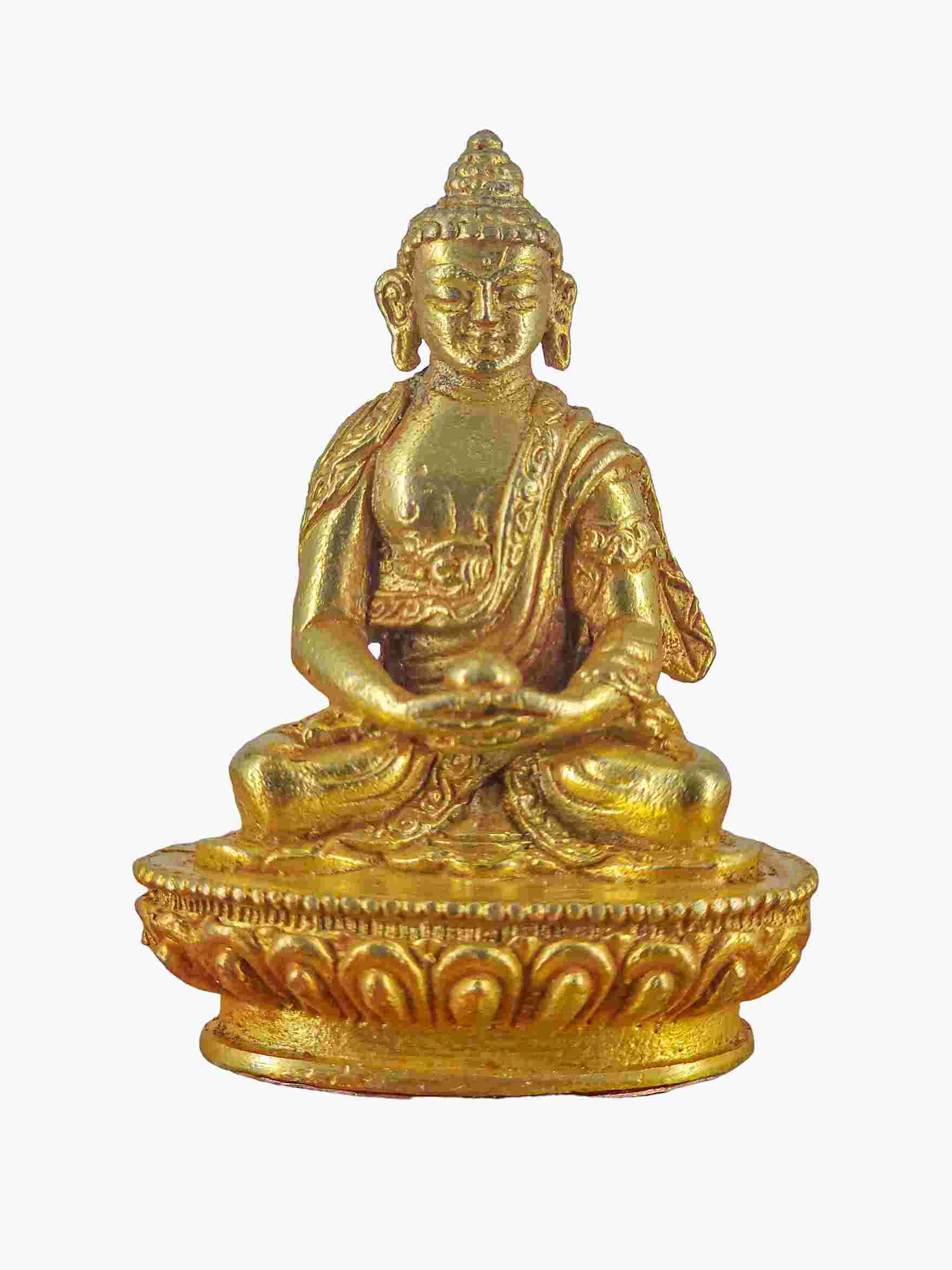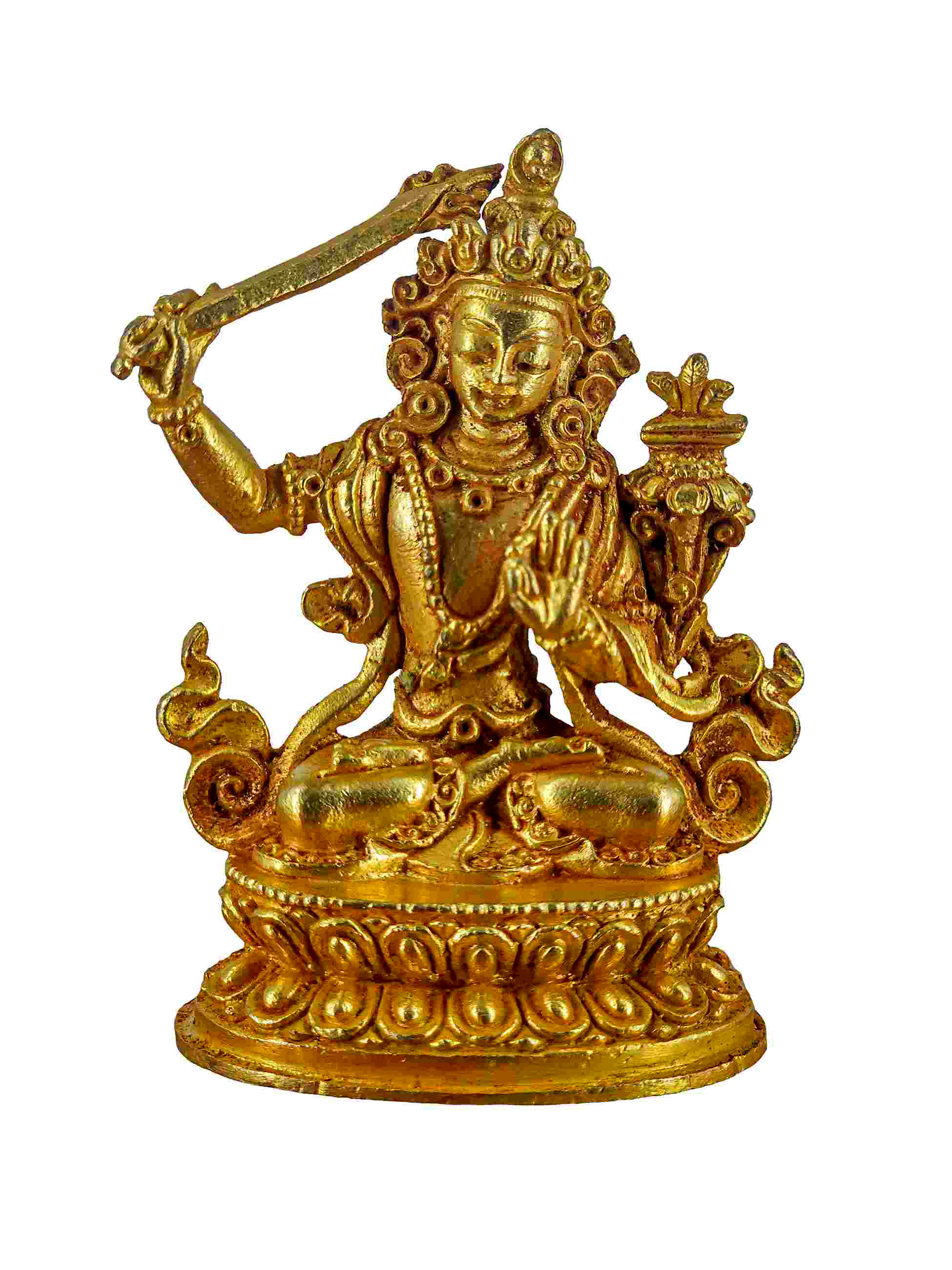Code
HCS5702
Weight
100 gm / 0.22 lbs
Size
Height
6cm (2") Width
4cm (2") Depth
3cm (1") Material
Copper
Availability
Subject to Avilability
Date Added
2010-10-14 09:08:44
Note : We used to sell this product 15 years ago so it may no longer be in our stock.
It is possible that we still have it with our suppliers but the price could be different from before.
Feel free to order. We will verify availability and inform you promptly.
It is possible that we still have it with our suppliers but the price could be different from before.
Feel free to order. We will verify availability and inform you promptly.

Safe Payment
We accept Paypal, Money Transfer, Bank Transfer
Confidence
Protection covers your purchase and personal data.
Worldwide Delivery
We ship Worldwide, except Russia.Shipping cost US$25.2 for upto 0.5 kgs

Hotline
Talk to help line for your question on 9841267335Old Post : OLD POST
Please note that this Amoghasiddhi Buddha Statue, [full Gold Plated], [old Post], [remakable] is an old post. We typically do not remove our posts from the website for various reasons, such as nostalgia and maintaining page ratings. These posts are not intended for direct sales, but occasionally, we can remake the items.
Please note that this Amoghasiddhi Buddha Statue, [full Gold Plated], [old Post], [remakable] is an old post. We typically do not remove our posts from the website for various reasons, such as nostalgia and maintaining page ratings. These posts are not intended for direct sales, but occasionally, we can remake the items.
Remakable : Remakable
Please note that the Amoghasiddhi Buddha Statue, [full Gold Plated], [old Post], [remakable] we posted some time ago is not currently available in our store. However, due to the possibility of a remake, it is still on sale. The remake will not be an exact replica of the original statue shown in the picture and will require additional time to be ready for dispatch. If you are willing to wait for this custom remake, you may proceed with your order. Thank you for your understanding and patience.
Please note that the Amoghasiddhi Buddha Statue, [full Gold Plated], [old Post], [remakable] we posted some time ago is not currently available in our store. However, due to the possibility of a remake, it is still on sale. The remake will not be an exact replica of the original statue shown in the picture and will require additional time to be ready for dispatch. If you are willing to wait for this custom remake, you may proceed with your order. Thank you for your understanding and patience.
About Elector Gold Plating
The Amoghasiddhi Buddha Statue, [full Gold Plated], [old Post], [remakable] has been crafted using the ceramic mold casting process, a modern approach that provides an alternative to traditional methods such as the lost-wax system or rubber molding. Also referred to as ceramic molding, this technique involves the creation of a ceramic mold to cast the statue. The process begins by making a precise and detailed wax model of the desired sculpture. The wax model is then coated with layers of ceramic material, creating a sturdy mold. Once the mold is complete, it is fired in a kiln, causing the wax to melt and escape, leaving behind a cavity that perfectly replicates the original sculpture. Molten metal is then poured into the mold, allowing it to fill the cavity and take on the desired form. Once cooled and solidified, the ceramic mold is carefully broken away, revealing the final metal statue. Read More . . .
The Amoghasiddhi Buddha Statue, [full Gold Plated], [old Post], [remakable] has been crafted using the ceramic mold casting process, a modern approach that provides an alternative to traditional methods such as the lost-wax system or rubber molding. Also referred to as ceramic molding, this technique involves the creation of a ceramic mold to cast the statue. The process begins by making a precise and detailed wax model of the desired sculpture. The wax model is then coated with layers of ceramic material, creating a sturdy mold. Once the mold is complete, it is fired in a kiln, causing the wax to melt and escape, leaving behind a cavity that perfectly replicates the original sculpture. Molten metal is then poured into the mold, allowing it to fill the cavity and take on the desired form. Once cooled and solidified, the ceramic mold is carefully broken away, revealing the final metal statue. Read More . . .
Lost-Wax System
This Statue : 2 Inches of Amoghasiddhi Buddha Statue, [full Gold Plated], [old Post], [remakable] is made by the process of the Lost Wax system. This is a very complicated, time consuming and historic process of making metal sculptures.Which is why it is sometimes called Precision Casting as well. Hence the sculptures made by this process are comparatively expensive. There are many new, advanced and less time consuming methods of casting metal sculptures available as well. But due to the benefits provided by the traditional lost wax system in quality control and customization, we prefer the Loss wax system over Ceramic molding, or sand casting to make our Statue : 2 Inches.
Below we have tried to illustrate the process of making a loss wax system statue: Read More . . .
This Statue : 2 Inches of Amoghasiddhi Buddha Statue, [full Gold Plated], [old Post], [remakable] is made by the process of the Lost Wax system. This is a very complicated, time consuming and historic process of making metal sculptures.Which is why it is sometimes called Precision Casting as well. Hence the sculptures made by this process are comparatively expensive. There are many new, advanced and less time consuming methods of casting metal sculptures available as well. But due to the benefits provided by the traditional lost wax system in quality control and customization, we prefer the Loss wax system over Ceramic molding, or sand casting to make our Statue : 2 Inches.
Below we have tried to illustrate the process of making a loss wax system statue: Read More . . .
Brief Introduction :
Amoghasiddhis is one of the five important Dhyani Buddhas. His name describes his characteristics perfectly. Amogha(Amoha) means the exclusion of confusion or spiritual ignorance, siddhi means Mastery in a subject. So in Amoghashiddhi is a Master to help remove confusion and spiritual ignorance.
"Mogha" can also be translated as a failure, unfruitful, or unsuccessful. Thus Amoghasiddhi is also the master of success, the one whose success cannot be obstructed. This is perhaps the most common description for Amoghasiddhi, "the Buddha of unobstructed success."
Teachings of Amoghashiddi :"Mogha" can also be translated as a failure, unfruitful, or unsuccessful. Thus Amoghasiddhi is also the master of success, the one whose success cannot be obstructed. This is perhaps the most common description for Amoghasiddhi, "the Buddha of unobstructed success."
Amoghasiddhi teaches us that Spiritual understanding is the deepest and fullest grasp of the universal truth that every experience and every object arises out of certain conditions. Likewise, every object and every experience becomes part of the conditions out of which other objects and experiences in turn arise.
A dynamic, endlessly unfolding. That is Amoghasiddhi's field, his home. So the wisdom of dwelling in this place is the wisdom of actions that are perfected. Actions are performed for the good of all beings, and the actions accomplish that perfectly. This world of perfected action is one of perfected conditions: harmonious, serene, pure.
Icongraphy of Amogshiddhi :A dynamic, endlessly unfolding. That is Amoghasiddhi's field, his home. So the wisdom of dwelling in this place is the wisdom of actions that are perfected. Actions are performed for the good of all beings, and the actions accomplish that perfectly. This world of perfected action is one of perfected conditions: harmonious, serene, pure.
Amoghasddhi's direction is the north. His time is midnight and so in visualizing Amoghasiddhi he is surrounded by a sky of midnight blue. His element is air, and thus he has the power of the wind, both fierce and gentle, warming and cooling, a baby's breath, a tree-breaker. His particular wisdom, as we have discovered, is the wisdom of all accomplishing action. He is described as the Buddha of the realization of the Bodhisattva path, a Buddha of actions, actions perfected and free of karmic consequences, actions that are pure, crystallized and transparent.
Amoghasiddhi's color is green. His vehicle is Garudha a half human and half bird, mythical imaginary creature. Amoghasiddhi's sits in abhaya mudra with his right hand held palm facing outward in front of the heart, this Mudras mean protection and removal of fear. That quality of fearlessness essential to living the spiritual life. His spiritual object is the double dorje that symbolizes the highest comprehension of truth, the incomparable power of a Buddha.
Amoghasiddhi's color is green. His vehicle is Garudha a half human and half bird, mythical imaginary creature. Amoghasiddhi's sits in abhaya mudra with his right hand held palm facing outward in front of the heart, this Mudras mean protection and removal of fear. That quality of fearlessness essential to living the spiritual life. His spiritual object is the double dorje that symbolizes the highest comprehension of truth, the incomparable power of a Buddha.
Mantra of Amoghsiddhi
OM AMOGHASIDDHI AH HUM


![Amoghasiddhi Buddha Statue, [full Gold Plated], [old Post], [remakable]](https://handicraftseller.com/uploads/pics/product/thumb/2010/10/5702.jpg)
![Amoghasiddhi Buddha Statue, [full Gold Plated], [old Post], [remakable]](https://handicraftseller.com/uploads/pics/product/thumb/2010/10/5702_0.jpg)


























































 Full Gold Plated,
Full Gold Plated,  Full Gold Plated,
Full Gold Plated,  of Green Tara,
of Green Tara,  of Green Tara,
of Green Tara,  of Aparimita,
of Aparimita,  of Aparimita,
of Aparimita,  Full Gold Plated,
Full Gold Plated,  Full Gold Plated,
Full Gold Plated,  of Amitabha Buddha,
of Amitabha Buddha,  of Amitabha Buddha,
of Amitabha Buddha,  of Aparimita,
of Aparimita,  of Aparimita,
of Aparimita,  of Vairochana Buddha,
of Vairochana Buddha,  of Vairochana Buddha,
of Vairochana Buddha,  Full Gold Plated,
Full Gold Plated,  Full Gold Plated,
Full Gold Plated,  of Manjushri,
of Manjushri,  of Manjushri,
of Manjushri,  of White Tara,
of White Tara,  of White Tara,
of White Tara,